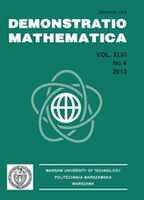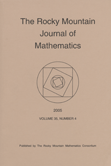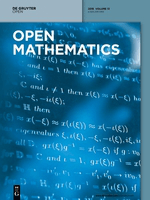
Eurasian Mathematical Journal
Scope & Guideline
Fostering Scholarly Exchange in Mathematics.
Introduction
Aims and Scopes
- Functional Analysis and Inequalities:
The journal prominently features studies related to functional analysis, particularly inequalities involving various function spaces, such as Morrey spaces and Lorentz spaces. - Differential Equations and Dynamical Systems:
There is a consistent emphasis on the analysis of differential equations, including nonlinear and impulse differential equations, as well as dynamical systems featuring hysteresis and optimal control. - Approximation Theory and Interpolation:
Research on approximation methods, particularly trigonometric approximation and interpolation techniques in various mathematical settings, is a significant focus area. - Operator Theory:
The journal delves into operator theory, exploring properties of different classes of operators, including Riemann-Liouville operators and their boundedness in various functional spaces. - Algebra and Group Theory:
Papers discussing algebraic structures, including groups and modules, reflect the journal's commitment to exploring the foundational aspects of mathematics. - Mathematical Modeling:
The journal encourages submissions that apply mathematical theories and methods to model real-world phenomena, particularly in physics and engineering contexts.
Trending and Emerging
- Nonlinear Functional Analysis:
There is a growing trend in research focusing on nonlinear functional analysis, particularly concerning the existence of solutions to nonlinear equations and systems, highlighting its importance in applied mathematics. - Advanced Inequalities and Operator Theory:
Recent works emphasize the exploration of advanced inequalities in various function spaces and the properties of operators, indicating a deepening interest in these areas. - Complex Systems and Mathematical Modelling:
The journal is increasingly featuring studies that utilize mathematical modeling to address complex systems, reflecting a broader interdisciplinary trend. - Time Scales and Dynamic Equations:
Research on dynamic inequalities and equations on time scales is emerging, showcasing innovative approaches to analyze systems that evolve over different time modalities. - Applications of Mathematical Concepts:
There is an evident trend towards applying mathematical theories to real-world problems, particularly in engineering and physical sciences, which enhances the practical relevance of the research published.
Declining or Waning
- Classical Real Analysis:
Topics specifically focused on traditional real analysis, such as elementary properties of functions, have seen reduced representation in recent publications. - Basic Algebraic Structures:
While algebra remains a core area, the focus on basic algebraic structures without deeper applications or connections to other fields has diminished. - Simple Geometric Methods:
Research relying solely on elementary geometric methods, without integration with more complex analytical or computational approaches, appears to have decreased. - Statistical Methods in Pure Mathematics:
The intersection of pure mathematics with statistical methods has become less prevalent, suggesting a shift towards more rigorous mathematical techniques.
Similar Journals

CZECHOSLOVAK MATHEMATICAL JOURNAL
Elevating Understanding through Rigorous InquiryCzechoslovak Mathematical Journal is a distinguished academic journal published by Springer Heidelberg, dedicated to advancing the field of mathematics through the dissemination of high-quality research. With an ISSN of 0011-4642 and E-ISSN 1572-9141, this journal has been a pivotal platform for mathematicians and researchers from around the globe since its inception. The journal holds a Q3 ranking in the field of Mathematics (miscellaneous), demonstrating its commitment to providing a forum for the latest mathematical theories and applications, particularly in general mathematics, as indicated by its Scopus rank of #285/399 and 28th percentile in the field. While currently not offering open access options, the journal continues to attract a wide readership by making its valuable content available through traditional subscription models. The Czechoslovak Mathematical Journal serves as an essential resource for researchers, professionals, and students aiming to stay informed about recent developments and breakthroughs in mathematics, with focus years converging from 1995 to 2024.

Revista Matematica Complutense
Championing High-Impact Research in MathematicsRevista Matematica Complutense is a prestigious peer-reviewed journal published by SPRINGER-VERLAG ITALIA SRL, specializing in the field of mathematics. With its ISSN 1139-1138 and E-ISSN 1988-2807, the journal plays a vital role in disseminating high-quality research and fostering academic discussion within the mathematics community. Recognized for its rigorous selection process, the journal has achieved impressive rankings, holding a Q1 quartile status in the miscellaneous mathematics category as of 2023 and ranking #94 out of 399 in general mathematics according to Scopus, placing it within the 76th percentile. With a publication timeline spanning from 2008 to 2024, the Revista Matematica Complutense continues to serve as an essential resource for researchers, professionals, and students alike. Although it does not currently offer open access, the journal remains committed to advancing mathematical knowledge and providing a platform for innovative research across various mathematical disciplines.

Demonstratio Mathematica
Elevating the Standards of Mathematical InquiryDemonstratio Mathematica, published by DE GRUYTER POLAND SP Z O O, is an esteemed open-access journal in the field of mathematics, with an ISSN of 0420-1213 and E-ISSN 2391-4661. Established in 1996 and providing open access since 2009, it has become a vital platform for disseminating innovative research and advancements in various areas of mathematics. With a commendable Scopus ranking of 85/399 in General Mathematics and a 2023 Category Quartile of Q2, it stands at the forefront of the mathematical community, demonstrating a significant impact within the top 78th percentile. The journal aims to foster a deeper understanding and appreciation of mathematical concepts and their applications, catering to both seasoned researchers and emerging scholars. Located in Warsaw, Poland, Demonstratio Mathematica not only enriches the academic discourse but also strengthens collaborative efforts within the international mathematics community, making it an essential resource for those seeking to expand their knowledge and research output.

Carpathian Journal of Mathematics
Pioneering Research in the Carpathian Mathematical LandscapeCarpathian Journal of Mathematics, published by NORTH UNIV BAIA MARE in Romania, is an esteemed research platform dedicated to the diverse and evolving field of mathematics. With an impressive Q2 ranking in the 2023 Mathematics (miscellaneous) category, this journal serves as a vital resource for researchers and practitioners alike, offering insights into both theoretical and applied mathematics. Spanning from its inception in 2003 to the anticipated contributions in 2024, it has established itself as a reputable source with a significant impact, reflected in its Scopus rank of #84/399 in General Mathematics, positioning it in the 79th percentile. Although it operates without open access, the journal ensures that subscribers, institutions, and readers enjoy rigorous peer-reviewed content that pushes the boundaries of mathematical inquiry. From algebra and number theory to applied mathematics and mathematical modeling, the Carpathian Journal of Mathematics stands as a beacon for innovation and scholarly dialogue, catering to an audience eager to contribute to and learn from the mathematical sciences.

SIBERIAN MATHEMATICAL JOURNAL
Connecting Scholars Through Rigorous Peer ReviewThe Siberian Mathematical Journal is a prestigious academic publication dedicated to advancing the field of mathematics, particularly in the areas of theoretical and applied research. Published by the esteemed MAIK Nauka/Interperiodica/Springer, this journal has been a vital resource for mathematicians since its inception in 1966, with a commitment to disseminating high-quality research until 2024. Featuring an ISSN of 0037-4466 and E-ISSN 1573-9260, the journal is categorized in Q2 within miscellaneous areas of mathematics, showcasing its scholarly significance as evidenced by its Scopus rank of #257 out of 399 in General Mathematics. While it does not provide open access options, the Siberian Mathematical Journal is renowned for its rigorous peer-review process and a 35th percentile ranking, making it a crucial publication for researchers, professionals, and students who seek to stay abreast of the latest mathematical discoveries and methodologies.

ROCKY MOUNTAIN JOURNAL OF MATHEMATICS
Exploring the Depths of Mathematical InnovationROCKY MOUNTAIN JOURNAL OF MATHEMATICS, published by the Rocky Mountain Math Consortium, serves as a critical platform for researchers and practitioners in the field of mathematics since its inception in 1971. With a notable presence in the academic community, this journal covers a broad spectrum of mathematical disciplines, positioning itself in the Q2 category for Mathematics (miscellaneous) as of 2023. Despite being a subscription-based journal, it is recognized for its rigorous peer-review process and contributions to theoretical and applied mathematics, helping to advance knowledge and foster collaboration among mathematicians. The journal's ISSN number is 0035-7596 and its E-ISSN is 1945-3795, reflecting its commitment to accessibility and dissemination of high-quality research. Based in Tempe, Arizona, at Arizona State University, the journal continues to play an important role in shaping contemporary mathematical discourse through well-researched articles and innovative studies, aiming to bridge gaps between various mathematical subfields and engage a diverse audience, including students and established researchers alike.

Open Mathematics
Championing Transparency in Mathematical InnovationOpen Mathematics, published by DE GRUYTER POLAND SP Z O O, is a prominent peer-reviewed journal that has been a vital platform for disseminating innovative research in the field of mathematics since its inception in 2015. With an impressive impact factor reflected by its Q2 ranking in the miscellaneous mathematics category and a commendable Scopus rank of #91 out of 399, it positions itself as a significant contributor to the mathematical community. This open access journal, headquartered in Poland, welcomes submissions that tackle diverse mathematical theories, applications, and methodologies, fostering knowledge exchange among researchers, professionals, and students globally. Since its launch, Open Mathematics has focused on bridging the gap between theoretical advancement and practical applications, making it an essential resource for anyone seeking to stay at the forefront of mathematical research and innovation. The journal offers easy online access, enhancing the visibility and impact of the valuable work published within its pages.

Dolomites Research Notes on Approximation
Elevating Mathematical Discourse through Open AccessDolomites Research Notes on Approximation (ISSN: 2035-6803) is a distinguished open access journal published by PADOVA UNIV PRESS, based in Italy. Since its inception in 2009, the journal has become a vital resource for researchers and professionals in the fields of applied mathematics and miscellaneous mathematics. With its current quartile rankings in Q3 for Applied Mathematics and Q2 for Mathematics (Miscellaneous) as of 2023, Dolomites Research Notes provides a platform for high-quality research insights and breakthroughs. Ranked #34 out of 90 in the miscellaneous mathematics category and #389 out of 635 in applied mathematics on Scopus, the journal maintains a strong global presence in the academic community. Its commitment to disseminating innovative research from 2013 to 2024 makes it essential reading for those engaged in the mathematical sciences. Researchers, students, and academics alike will benefit from the wealth of knowledge presented in its articles, fostering continued advancement and exploration in the field.

Italian Journal of Pure and Applied Mathematics
Exploring the Frontiers of Mathematical KnowledgeThe Italian Journal of Pure and Applied Mathematics, published by FORUM EDITRICE UNIV UDINESE, is an esteemed platform dedicated to the dissemination of high-quality research within the field of mathematics. With an ISSN of 1126-8042 and an E-ISSN of 2239-0227, this journal serves as a crucial resource for mathematicians seeking to contribute to current discussions and advancements in both pure and applied mathematical sciences. Although the journal currently holds a quartile rank of Q4 in the field of miscellaneous mathematics and is positioned within the 10th percentile of Scopus rankings, it remains committed to fostering valuable academic discourse. This journal particularly welcomes submissions that explore innovative mathematical theories and methodologies, offering a unique insight into the diverse aspects of mathematical research. Operating under a traditional access model, it provides a gateway for researchers, professionals, and students to deepen their understanding and expand their contributions to the mathematical community. With coverage spanning from 2010 to 2024, the journal continues to enhance its reputation as a reliable source of contemporary mathematical scholarship.

PUBLICATIONES MATHEMATICAE DEBRECEN
Advancing Mathematical Frontiers with Rigorous ResearchPublicationes Mathematicae Debrecen is a renowned international journal published by the University of Debrecen, Institute of Mathematics, situated in Hungary. This journal, with both ISSN 0033-3883 and E-ISSN 2064-2849, has established itself in the field of mathematics since its inception, with coverage extending from 1997 to 2024. Recognized for its rigorous academic standards, it currently holds a Q3 ranking in the mathematics (miscellaneous) category for 2023 and ranks at the 42nd percentile among general mathematics journals in Scopus. Publicationes Mathematicae Debrecen aims to disseminate high-quality research across various areas of mathematics, contributing to the advancement of knowledge and practice in this dynamic field. Although it is not an open-access journal, its readers can access a wealth of scholarly work that addresses both theoretical and applied mathematical issues, making it an invaluable resource for researchers, professionals, and students alike.